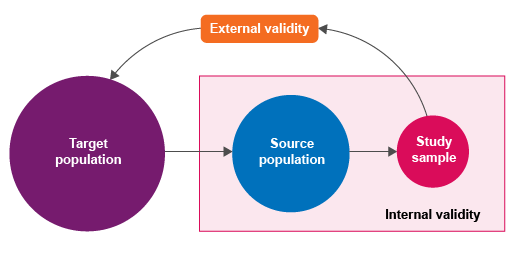1.3 Sampling and validity
Why is it important to describe and identify these sampling parameters?
Here, we need to think about the ‘validity’ of sampling: how well a measurement represents the true situation. If you have already completed the Fundamentals of data for AMR module, you may recall that the concepts of
Epidemiological principles of sampling in animal populations are the same as the principles applied to sampling in human populations. In animal health, it is similarly necessary to define the target population, the source population, the study sample and the sampling unit. In animal health, a flock, herd or other group might be the lowest-level sampling unit: this is because in a herd, all the animals are in the same physical area and exposed to identical risk factors. By comparison, an individual is the most common lowest-level sampling unit in human health.
Activity 3 has an example of this.
Activity 3: Extracting useful sampling information
Read the following abstract from a study describing surveillance of AMR in bacteria causing urinary tract infections (UTIs) in Indonesia (Sugianli et al., 2017). Use the space below to identify the target population, source population, study sample and sampling unit.
Objectives: UTIs are a common reason for empirical treatment with broad-spectrum antibiotics worldwide. However, population-based antimicrobial resistance (AMR) prevalence data to inform empirical treatment choice are lacking in many regions, because of limited surveillance capacity. We aimed to assess the prevalence of AMR to commonly used antimicrobial drugs in Escherichia coli and Klebsiella pneumoniae isolated from patients with community- or healthcare-associated UTIs on two islands of Indonesia.
Methods: We performed a cross-sectional patient-based study in public and private hospitals and clinics between April 2014 and May 2015. We screened patients for symptoms of UTIs and through urine dipstick analysis. Urine culture and susceptibility testing were supported by telemicrobiology and interactive virtual laboratory rounds. Surveillance data were entered in forms on mobile phones.
Results: Of 3424 eligible patients, 3380 (98.7%) were included in the final analysis, and yielded 840 positive cultures and antimicrobial susceptibility data for 657 E. coli and K. pneumoniae isolates. Fosfomycin was the single oral treatment option with resistance prevalence E. coli and K. pneumoniae in community settings. Tigecycline and fosfomycin were the only options for treatment of catheter-associated UTIs with resistance prevalence K. pneumoniae.
Conclusions: Patient-based surveillance of AMR in E. coli- and K. pneumoniae-causing UTIs indicates that resistance to the commonly available empirical treatment options is high in Indonesia. Smart AMR surveillance strategies are needed to inform policy-makers and to guide interventions.
Discussion
How did you find this exercise? Was there enough information available in the abstract to complete this activity?
The target population is the population who have community- or healthcare-associated UTIs in Indonesia – this is the population to which the authors extrapolate their findings in the conclusions of the abstract. You should reflect on whether you agree with the authors that this is an appropriate target population, considering the study was conducted on only two islands in Indonesia.
The source population is the patients with UTIs attending public or private hospitals and clinics in two islands in Indonesia between April 2014 and May 2015. The source population is estimated to be 3424 eligible patients.
The study sample is 3380 patients, which is 98.7% of the source population.
The sampling unit is a patient with a UTI.
1.2 Sampling terminology




